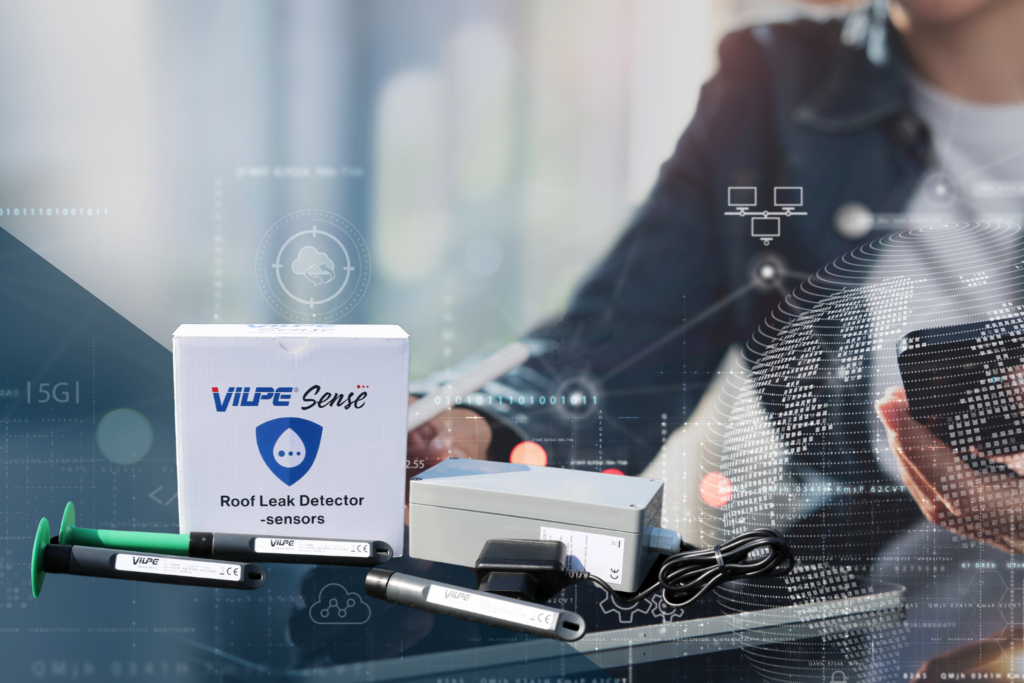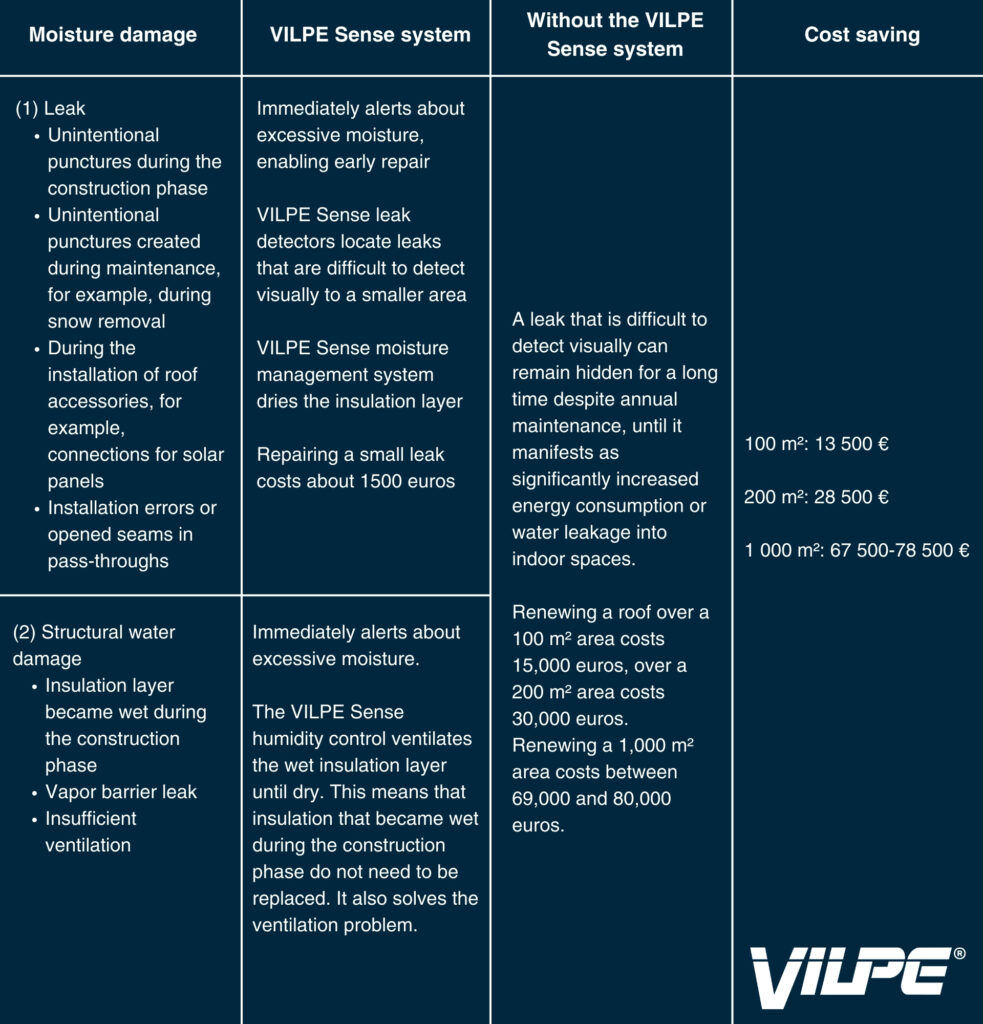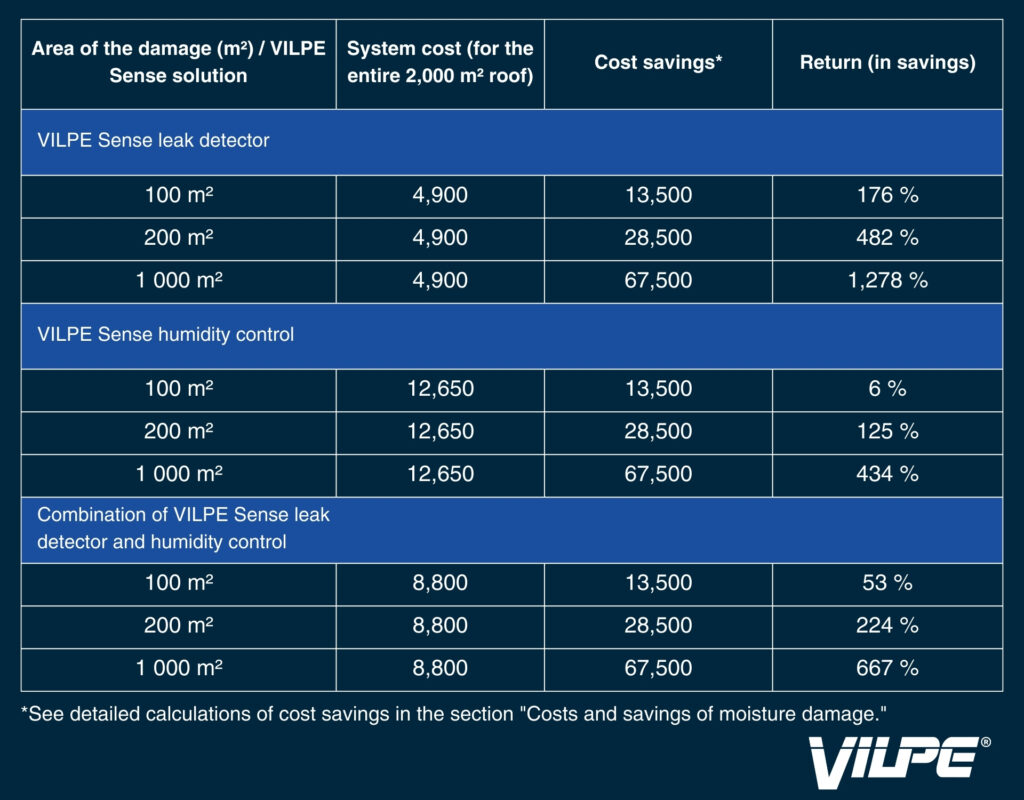VILPE Sense Saves Money if It Prevents Even One Major Moisture Damage

The preliminary purpose of VILPE Sense is to prevent larger moisture damages and thereby save on repair costs. The return on investment for the VILPE Sense system in savings from repair costs was evaluated for three VILPE Sense solutions on a hypothetical 2,000 m2 roof. The results show that an investment in any of the three VILPE Sense solution options yields savings if the system prevents even one instance of moisture damage on a roof area of 100 m2 or larger. The investment in a VILPE Sense solution meets the common yield requirement for investments aimed to reduce costs (12–15%).
Property owners are constantly seeking ways to reduce maintenance-related costs. Various types of moisture damage, such as roof leaks, often lead to expensive repair costs. Since time is a critical factor in the severity and cost of moisture damage, responding quickly to problems helps prevent a larger roof repair. The VILPE Sense products have been developed to address this issue by alerting to excessive moisture in structures. The general yield requirement for cost-reducing investments is considered 12–15%. In this article, we examine the savings brought by an investment in VILPE Sense products. The calculation was made for three different VILPE Sense solutions on a hypothetical 2,000 m2 low-slope bitumen roof with a vapor barrier and insulation.
Investments costs of the VILPE Sense system
The VILPE Sense product family includes two systems. The VILPE Sense leak detection system monitors and alerts when it detects a leak in the roof. The potential leak can be located on a larger roof area from the leak detection system’s humidity map, enabling quick repair of the leak. Like the leak detector, the VILPE Sense humidity control system also monitors the moisture levels of the roof in real-time and alerts to problems. The VILPE Sense humidity control system also includes a roof fan, which ventilates the roof structures as needed and thus drying the insulation layer. This means that, for example, insulating materials that got wet during the construction phase do not need to be replaced because the VILPE Sense humidity control system takes care of the drying. For VILPE Sense humidity control to function optimally, air needs to be able to circulate within the structures, for instance by using insulation with ventilation grooves. Both systems can be used separately or in combination. In this article we calculate the savings for three VILPE Sense solutions for a 2,000 m2 roof. All price estimates reported here are based on Finnish data. A new 2,000 m2 roof costs at least 162,000 euros.
In the first solution, the entire roof is monitored by VILPE Sense leak detectors. This solution requires the following products: 100 VILPE Sense leak detectors, and 1 VILPE Sense base station. The products, including installation and electrical work, cost approximately 4,900 euros (2.5 euros/m2), which is 3% of the roof’s price.
In the second solution, the entire roof is monitored and ventilated by the VILPE Sense humidity control system and it has ventilation grooves. This solution includes the following products: 10 VILPE Sense basic kits, 10 ECo Sense roof fans, 20 underpressure vents, and 1 VILPE Sense base station. The products, including installation and electrical work, cost approximately 12,650 euros (6.33 euros/m2), which is 7.8% of the roof’s price.
The third solution combines both systems, where the VILPE Sense humidity control system ventilates critical areas of the roof, and leak detectors monitor the rest of the roof. The roof has ventilation grooves. This solution requires the following products: 5 VILPE Sense basic kits, 5 ECo Sense roof fans, 15 underpressure vents, 50 VILPE Sense leak detectors, and 1 VILPE Sense mobile base station. The products, including installation and electrical work, cost approximately 8,800 euros (4.40 euros/m2), which is 5.4% of the roof’s price.
Price estimates for calculations
The price estimates for moisture damage in this article are based on price information from real roofing contractors in Finland. However, it’s important to note that the costs of roof construction and repair are influenced by many factors, and prices can vary greatly, depending on, for example, how difficult it is to work on the roof, the location of the building, and how much equipment and other structures are to be installed on the roof. Here, the estimates for repair costs are slightly on the conservative side. All prices in this article are calculated excluding VAT (0%).
Not all costs associated with moisture damage have been considered in this calculation. For instance, wet insulation loses its insulating capacity, thereby increasing the building’s energy consumption. Also, leaks can cause damage to property inside the building and thus add costs.
Costs and savings of moisture damage
Moisture damages on roofs can broadly be divided into two categories: leaks and structural moisture damages. A leak refers to a hole in the roof, such as a detached seam. Structural damage means that moisture accumulates in the structure due to other reasons, such as inadequate ventilation not removing condensation water formed within the structures or construction-phase moisture in building materials like wet insulation.
Repairing a minor leak involves patching the leak site and replacing at most 1 m2 of the insulation. The cost of repairing a small leak is about 1,500 euros. If the leak or other moisture has wetted the insulation and structures more extensively, it is assumed that the roof area needs to be replaced, meaning replacement of insulation and surface materials over a larger area. In this examination, costs are calculated if 100, 200, or 1,000 m2 of the roof area needs to be replaced. Replacing 100 m2 of roof area costs 15,000 euros, 200 m2 costs 30,000 euros, and replacing 1,000 m2 of roof area costs at 69,000 euros at minimum. Roof repair costs are not linear; roof costs decrease proportionally as the repair area increases.
In evaluating VILPE Sense and savings, the probability of moisture damages on roofs should also be considered. According to roofing experts, leaks and other moisture damages are common. However, since moisture damages are not covered by insurance, they are also not recorded. For this reason, there is no reliable information on the prevalence of moisture damages on roofs. However, calculations show that if the VILPE Sense system can prevent the development of even one minor leak into a more extensive moisture damage, the cost savings are significant; 13,500 euros from a 100 m2 area, 28,500 euros from a 200 m2 area, and 67,500–78,500 euros from a 1,000 m2 area (see Table 1). The cost savings are net of the repair cost of a small leak (1,500 euros).
Table 1: The costs of moisture damage and the cost savings generated by VILPE Sense

Calculation of the savings brought by VILPE Sense
The return on investment (ROI) from the savings provided by VILPE Sense was calculated as follows: the cost saving was subtracted by the system’s investment cost, and the result was divided by the same investment cost. The system cost refers to the investment cost including products and installation for the entire roof. Cost saving refers to the savings that arise when a certain roof area does not need to be replaced. In the calculation, the cost savings were adjusted by deducting the costs of repairing a minor leak (€1,500). For example, in a solution where VILPE Sense leak detectors monitor the roof, a cost saving of €13,500 is generated when a 100 m² roof area does not need to be replaced.
Table 2: Calculations of the savings generated by three VILPE Sense solution options on a 2,000 m² roof

Based on the calculations, investing in any of the three VILPE Sense solution options results in savings if the system prevents at least one instance of damage on a roof area of 100 m² or larger (see Table 2). The general yield requirement for cost-reducing investments is 12-15%. This figure is achieved in all example calculations except one.
